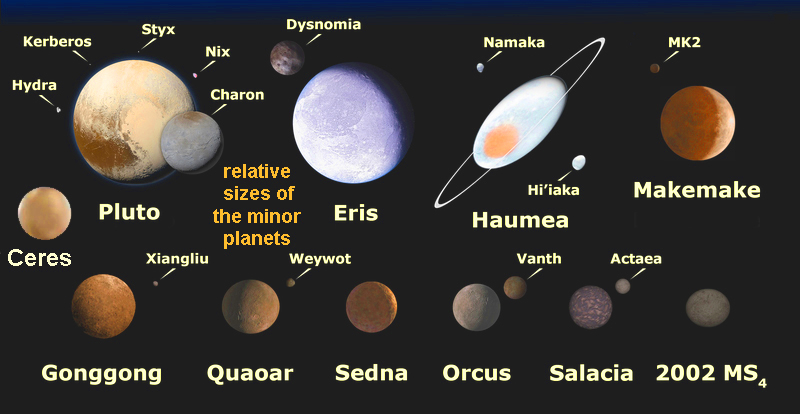|
artist's rendition of the eleven largest minor planets discovered/recognized thus far There are only eleven or so large minor planets known thus far(Feb 2023) with diameters of 500 miles or more. This may change in the future. There is a large gap in size between first two bodies(Pluto and Eris) and the rest. I have always stated that in order for a body to be considered a true or major planet it must be at least 1200 miles(1931 kilometers) in diameter. There is no authority on this, it is just my own strongly felt opinion or intuition. Size is important. Whether the astronomers are correct on the sizes given here is debatable, but it is hoped that they are, at least in ratio or relative to one another. Distance is not necessarily as important as the TIME it takes for these bodies to move through their orbits. If you are a flat Earther, distance has no bearing whatsoever. All bodies will be seen as projections against the dome or firmament, and the true sizes and distances will only be a tiny fraction of what the astronomers give them. Modern astrologers rely on astronomers for their information on the minor planets. While modern astronomers do not generally like be associated with astrologers, this was not so only a century or more ago, when the two disciplines worked naturally together. This modern schism must be dissolved and healed. Astronomy is rather meaningless without astrology, and astrolgy is chaotic, messy, or even incomplete without astronomy. Both need each other. It's the same with religion and the occult. Pluto, a minor or "dwarf" planet to astronomers, is considered a bonafide major planet to most astrologers, and Eris may soon join the fold as well. The other bodies may have significant influences as well, but less so than the major "twelve" which include the luminaries(Sun and Moon), Mercury through Pluto, and possibly Terra or the Earth(Ascendant) as well. One can liken the major and minor bodies to the major gods and the demi-gods. The demi-gods or minor planets must grow and develop and be accounted worthy before they can hope to be included in the pantheon, and then only if there is a vacancy(the number must always be twelve). The exception to the size rule in astrology may be 2060 Chiron. Discovered on Nov.1st,1977, Chiron is a tiny body(only some 200+ km diameter), but it is the leader of a new class of objects known as centaurs which, in astrology bridge the effects of various planets(Saturn and Uranus in this case). Chiron has been observed by astrologers to exercise significant spiritual or "New Age" influence and therefore merits consideration as a minor planet or body. Astronomy as is, is a cold and largely deceptive discipline, a somewhat anti-theistic product of the Copernican revolution, which must undergo a major revision. It has no real bearing to our lives on Earth. All those promises of escaping to other planets may in all likelihood be fictitious. The real action is here on Earth (which is a level and far larger Earth), and the heavenly bodies are just reflections or indicators of this.
back to home |
